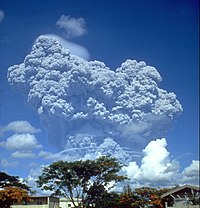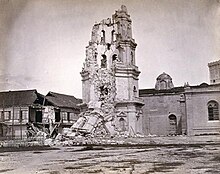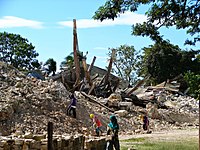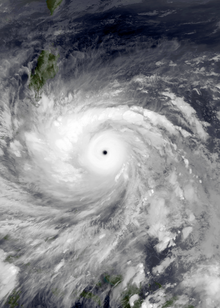List of disasters in the Philippines
Appearance
(Redirected from Natural disasters in the Philippines)
This is a list of disasters in the Philippines.
Volcanic eruptions
[edit]


| Event | Date | Notes |
|---|---|---|
| Leonard Kniaseff | c.120 AD.[1] | There was a scare in 1995 but PHIVOLCS investigation at the time did not disclose any unusual activity, and no unusual activity has been reported since. |
| San Pablo Volcanic Field | 1350 AD +/- 100 | Last activity was the formation of Sampaloc Lake around 1350 AD +/- 100 years determined by anthropology[2] |
| Taal eruption | 1572 to 2022 | Currently on eruption since January 12, 2020. Eruptions have also destroyed numerous lakeside towns, burying them with volcanic ash or submerged them by rising lake waters displaced by the erupted material. The towns of Lipa, Taal, Sala, Bauan and Tanauan were formerly located along Taal Lake. Presently, only three towns are on the lake's shore. Remnants of the old lakeside towns are reported to be seen under the lake's waters.[3] |
| Mayon eruption | 1616 to 2018 | The most destructive eruption of Mayon occurred on February 1, 1814 (VEI=4). Lava flowed but not as much compared to the 1766 eruption; Instead, the volcano was belching dark ash and eventually bombarded the town of Cagsawa with tephra that buried it. Trees were burned; rivers were certainly damaged. Proximate areas were also devastated by the eruption, with ash accumulating to 9 m (30 ft) in depth. In Albay, a total of 2,200 locals perished in what is considered to be the most lethal eruption in Mayon's history; estimates by PHIVOLCS list the casualties at about 1,200, however. The eruption is believed to have contributed to the accumulation of atmospheric ash,[citation needed] capped by the catastrophic eruption of Mount Tambora in 1815, that led to the Year Without a Summer in 1816. |
| Pinatubo eruption | 1500 to 2021 | Reawakened in 1991 producing the 2nd largest eruption in the 20th century. Followed by milder eruptions in 1992 and 1993.[4] |
| Mt. Kanlaon eruption | 1886 to 2024 | The most active volcano in the Visayas, Kanlaon has erupted 26 times since 1919. Eruptions are typically phreatic explosions of small-to-moderate size that produce minor ash falls near the volcano. In 1902, the eruption was classified as strombolian, typified by the ejection of incandescent cinder, lapilli and lava bombs. |
| Bulusan eruption | 1886 to 2022 | Bulusan is generally known for its sudden steam-driven or phreatic explosions. It has erupted 16 times since 1885 and is considered as the 4th most active volcano in the Philippines after Mayon, Taal, and Kanlaon. There are evacuation procedures in place for parts of the peninsula, the farms nearest the volcano are evacuated, and many of the village schools are closed if it is considered possible that a more destructive eruption could occur. |
| Mt. Hibok-Hibok eruption | 1827, 1862, 1871 and 1948–1952 | On February 16, 1871, earthquakes and subterranean rumblings began to be felt in Camiguin, which increased in severity until April 30 when a volcanic fissure opened up 400 yards southwest of the village of Catarman, on the northwest flank of the Hibok-Hibok Volcano. From the opening, lava was continuously ejected and poured into the sea for four years destroying the town. At the same time, the vent started gaining in height and width thus forming Mt. Vulcan. In 1875, the Challenger expedition visited the area, and described the mountain as a dome, about 1,950 feet (590 m) in height, without any crater, but still smoking and incandescent at the top.[5] |
Earthquakes
[edit]

The table below is a tally of the ten most deadly recorded earthquakes in the Philippines since the 1600s:
18th century
[edit]- An intensity VII struck Lake Bombon (now known as Taal Lake) on September 24, 1716. It was connected with the eruption of Taal volcano; the constant volcanic activity in the area of Taal caused seismic movements.
- An intensity IX struck Tayabas (now known as Quezon) in 1730. It had ruined the churches and convent in Mauban and several other churches in the province of Tayabas and Laguna.
19th century
[edit]- An earthquake on June 3, 1863, destroyed the Manila Cathedral, the Ayuntamiento (City Hall), the Governor's Palace (all three located at the time on Plaza Mayor, now Plaza de Roma) and much of the city. The residence of the Governor-General was moved to Malacañang Palace located about 3 km (1.9 miles) up the Pasig River, while the other two buildings were rebuilt in place.
- An intensity X struck Luzon on July 14–24, 1880.[6] The quake caused severe damage to these major cities in Luzon, most significantly in Manila where a lot of buildings collapsed. Number of casualties are unknown.[7]
- A quake struck Lucban, Quezon on October 26, 1884. It destroyed churches in Lucban and Cavinti in Laguna province.[7]
| Ten deadliest recorded earthquakes in the Philippines since the 1600s | ||||||||||
|---|---|---|---|---|---|---|---|---|---|---|
| Magnitude | Origin | Location | Date | Mortality | Missing | Injured | Damages | Source | ||
| 1 | 7.9 | Tectonic | Moro Gulf | August 16, 1976 | 4791 | 2288 | 9928 | |||
| 2 | 7.8 | Tectonic | Luzon Island | July 16, 1990 | 1621 | 1000 | More than 3000 | ₱10 billion | ||
| 3 | 7.5 | Tectonic | Luzon Island | November 30, 1645 | More than 600 | More than 3000 | Unknown | |||
| 4 | 7.3 | Tectonic | Casiguran, Aurora | August 2, 1968 | 271 | 261 | ||||
| 5 | 7.2 | Tectonic | Bohol & Cebu | October 15, 2013 | 222 | 8 | 796 | ₱4 billion (est.) | [8] | |
| 6 | 7.1 | Tectonic | Mindoro | November 15, 1994 | 78 | 430 | ₱5.15 million | [9] | ||
| 7 | 6.7 | Tectonic | Negros Oriental | February 6, 2012 | 51 | 62 | 112 | ₱383 million | ||
| 8 | 7.8 | Tectonic | Panay (Lady Caycay) | January 25, 1948 | 50 (est) | ₱7 million | ||||
| 9 | Unknown | Tectonic | Manila | June 19, 1665 | 19 | Unknown | ||||
| 10 | 6.5 | Tectonic | Laoag | August 17, 1983 | 16 | 47 | ||||
| 11 | 7.5 | Tectonic | Mindanao Island | March 5, 2002 | 15 | 100 | ||||
Typhoon
[edit]
| Rank | Storm | Dates of impact | Deaths | |
|---|---|---|---|---|
| 1 | 1881 Haiphong typhoon | 1881, September 27–October 6 | 20,000 | [10] |
| 2 | Haiyan/Yolanda 2013 | 2013, November 7–8 | 6,241 | [11] |
| 3 | Thelma (Uring), 1991 | 1991, November 2–7 | 5,956 | [13][14][15] |
| 4 | Bopha/Pablo 2012 | 2012, December 2–9 | 1,901 | |
| 5 | Angela Typhoon, 1867 | 1867, September 20–26 | 1,800 | [10][16][17] |
| 6 | Winnie 2004 | 2004, November 27–30 | 1,593 | |
| 7 | Fengshen/Frank 2008 | 2008, June 18–23 | 1,501 | [14] |
| 8 | Unidentified typhoon | 1897, October 7–16 | 1,500 | [10][16][17] |
| 9 | Ike (Nitang), 1984 | 1984, August 31–September 4 | 1,492 | [13] |
| 10 | Durian/Reming 2006 | 2006, November 29–December 1 | 1,399 |
| Costliest Philippine typhoons | |||||
|---|---|---|---|---|---|
| Rank | Names | Dates of impact | PHP | USD | Ref |
| 1 | Bopha, (Pablo) | November 25 – December 9, 2012 | 42.2 billion | 1.04 billion | [18] |
| 2 | Haiyan, (Yolanda) | November 3 – 11, 2013 | 35.5 billion | 809 million | [19] |
| 3 | Parma, (Pepeng) | October 2 – 10, 2009 | 27.3 billion | 608 million | [20] |
| 4 | Nesat, (Pedring) | September 26 – 28, 2011 | 15 billion | 333 million | [21] |
| 5 | Fengshen, (Frank) | June 20 – 23, 2008 | 13.5 billion | 301 million | [22] |
| 6 | Ketsana, (Ondoy) | September 25 – 27, 2009 | 11 billion | 244 million | [20] |
| 7 | Mike, (Ruping) | November 10 – 14, 1990 | 10.8 billion | 241 million | [23] |
| 8 | Angela, (Rosing) | October 30 – November 4, 1995 | 10.8 billion | 241 million | [23] |
| 9 | Flo, (Kadiang) | October 2 – 6, 1993 | 8.75 billion | 195 million | [23] |
| 10 | Megi (Juan) | October 18 – 21, 2010 | 8.32 billion | 193 million | [24] |
See also
[edit]- List of man-made disasters in the Philippines, for man-made disasters in the Philippines
- Earthquake
- List of active volcanoes in the Philippines
- List of earthquakes in the Philippines
- List of inactive volcanoes in the Philippines
- List of potentially active volcanoes in the Philippines
- PAGASA
- PHIVOLCS
- Typhoon
- Volcano
References
[edit]- ^ "Leonard Range Eruption History". Global Volcanism Program. Retrieved on 2011-08-18.
- ^ "San Pablo Volcanic Field Eruption History". Global Volcanism Program. Retrieved on 2011-08-18.
- ^ Hargrove, Thomas (1991). "The Mysteries of Taal, a Philippine volcano and lake, her sea life and lost towns". Bookmark, Manila. ISBN 971-569-046-7.
- ^ USGS. "Earthquake Information for 1990". Archived from the original on 2009-12-06. Retrieved 2010-03-06.
- ^ Becker, George F. (1901). "Report on the Geology of the Philippine Islands", p.42-43. Washington Government Printing Office, 1901.
- ^ Maso, Saderra (1902). Seismic and Volcanic Centers of the Philippine Archipelago. Manila: Bureau of Printing. p. 16.
- ^ a b Bautista, Maria Leonila P. & Bautista, Bartolome C. "Philippine Historical Earthquakes and Lessons Learned" (PDF). EqTAP Project. Archived from the original (PDF) on 2013-11-13. Retrieved 2014-06-10.
- ^ "Massive extremely dangerous earthquake in Bohol, Philippines – At least 222 people killed, 8 missing, over 790 injured, around 4 billion PHP damage, 7 billion PHP reconstruction costs". Earthquake-Report.com. October 31, 2013. Retrieved June 2, 2014.
- ^ "1994 Mindoro Tsunami". Philippine Institute of Volcanology and Seismology. Retrieved February 7, 2012.
- ^ a b c "Tropical Cyclone Disasters in the Philippines: A Listing of Major Typhoons by Month Through 1979" Retrieved 03-27-2018.
- ^ "TyphoonHaiyan - RW Updates". United Nations Office for the Coordination of Humanitarian Affairs. December 28, 2013. Philippines: Hundreds of corpses unburied after Philippine typhoon. Archived from the original on December 30, 2013. Retrieved December 30, 2013.
- ^ Leoncio A. Amadore, PhD Socio-Economic Impacts of Extreme Climatic Events in the Philippines. Archived 2008-10-02 at the Wayback Machine Retrieved on 2007-02-25.
- ^ a b "Typhoon2000.com:THE 10 WORST TYPHOONS OF THE PHILIPPINES (A SUMMARY)". www.Typhoon2000.ph. 2004. Archived from the original on 2008-05-22. Retrieved 2018-03-27.
- ^ a b "Typhoon2000.com:THE 12 WORST TYPHOONS OF THE PHILIPPINES (A SUMMARY)". www.typhoon2000.ph. 2010-07-29. Retrieved 2018-03-27.
- ^ "Top 25 Natural Disasters in Philippines (1901-2000)" Retrieved 03-26-2018.
- ^ a b Pedro Ribera, Ricardo Garcia-Herrera & Luis Gimeno (July 2008). "Historical deadly typhoons in the Philippines" (PDF). Weather. 63 (7): 196. Bibcode:2008Wthr...63..194R. doi:10.1002/wea.275.
- ^ a b "Historical deadly typhoons in the Philippines" Retrieved 03-27-2018.
- ^ "Archived copy" (PDF). Archived from the original (PDF) on 2013-11-10. Retrieved 2014-06-02.
{{cite web}}: CS1 maint: archived copy as title (link) - ^ Typhoon Haiyan death toll rises over 5,000 (Report). BBC. November 22, 2013. Retrieved November 22, 2013.
- ^ a b "Situation report no.50 on Typhoon Ondoy (Ketsana) and Typhoon Pepeng (Parma)" (PDF). Philippine National Disaster Coordinating Council. 2009-11-17. Archived from the original (PDF) on 2011-07-04. Retrieved 2010-05-14.
- ^ As Typhoon Nesat departs, Philippines tallies the damage | MNN - Mother Nature Network Archived 2014-07-03 at the Wayback Machine
- ^ "Archived copy" (PDF). Archived from the original (PDF) on 2008-09-09. Retrieved 2014-06-02.
{{cite web}}: CS1 maint: archived copy as title (link) - ^ a b c "Destructive typhoons 1970-2003". National Disaster Coordinating Council. 2009-05-01. Archived from the original on 2004-10-28. Retrieved 2010-05-13.
- ^ "Typhoon Juan Update" (PDF). NDRRMC (formerly NDCC). 2010-10-23. Archived from the original (PDF) on 2011-08-23. Retrieved 2010-10-23.
External links
[edit]- Official Website of the National Museum of Natural History
- http://www.preventionweb.net/english/countries/statistics/?cid=135
- http://www.gmanetwork.com/news/story/341514/scitech/science/the-7-worst-natural-calamities-to-hit-phl-in-2013
- http://www.philstar.com/headlines/2013/12/26/1272092/yearender-2013-year-major-natural-disasters
- http://www.mapreport.com/subtopics/d/countries/philippines.html
